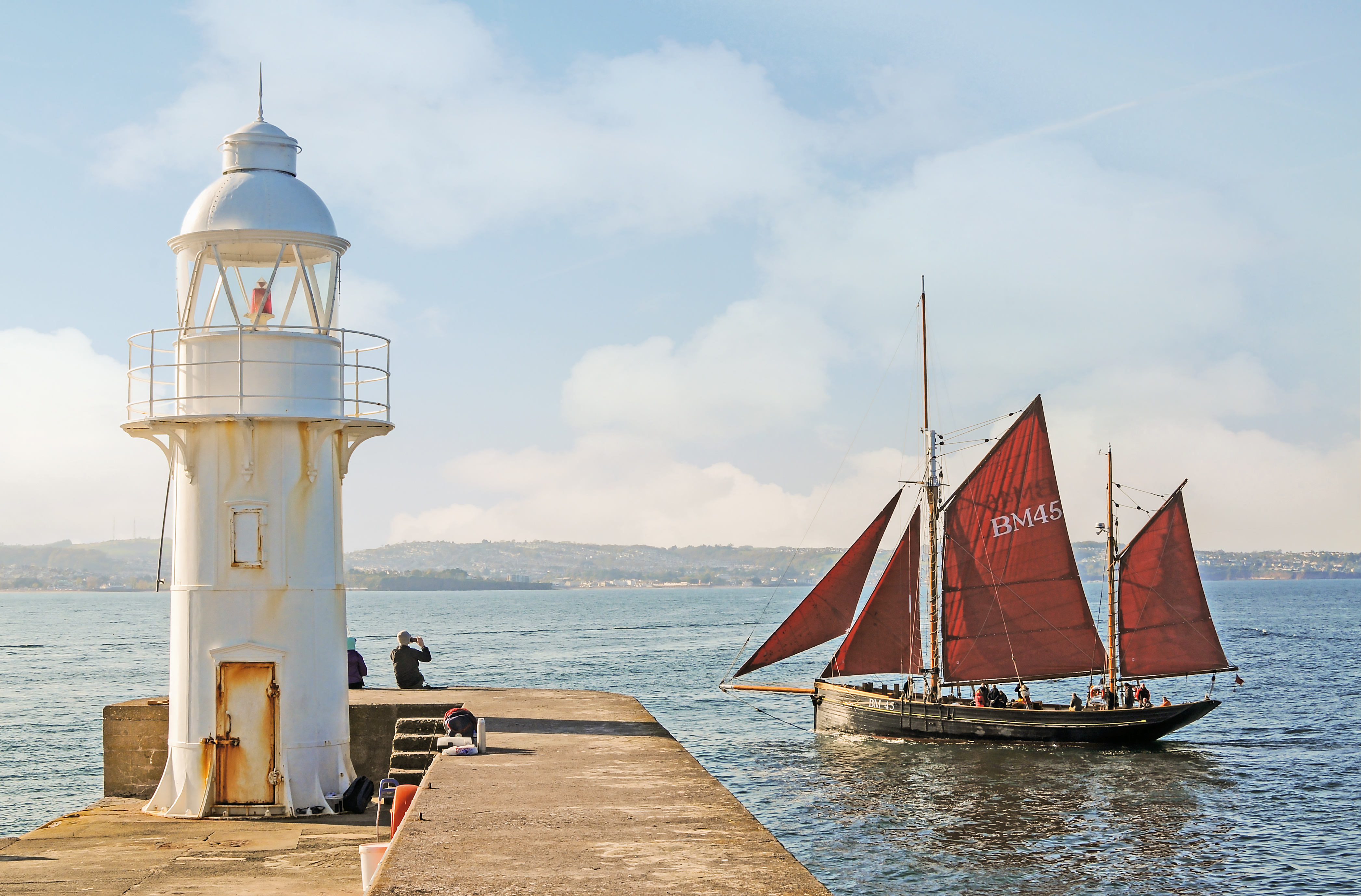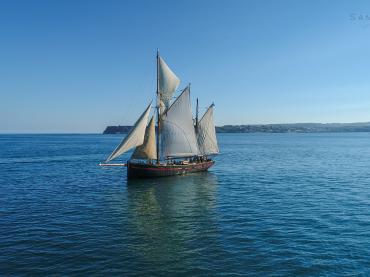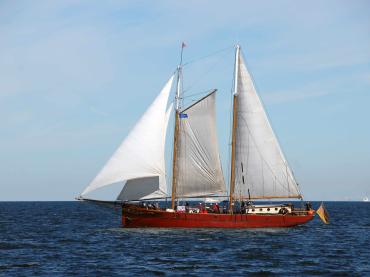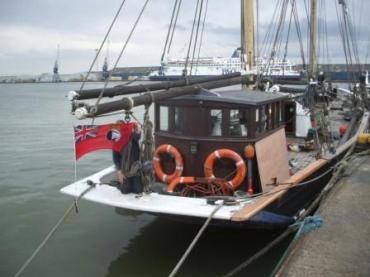


Details
Construction
Dimensions
History
PILGRIM was built at Brixham in 1895 by J W Upham, for Silas Pine and was constructed of elm planks on oak frames. At this time over 300 sailing trawlers were based at Brixham. At first PILGRIM was registered at Dartmouth with the number DH 394. From 1900 she fished out of Brixham, with the registration number BM 45, until 1912. At some point a 35 hp engine was fitted. John Cheney was her second owner in 1912
She was sold to Swedish owners, including Carl Leffler and two others, and arrived at Ahlviken, near Gothenburg on the west coast of Sweden on 8 July 1912 and then fished for seven years in that area. In 1919 she was sold on and converted into a motorised cargo vessel, working out of Halmstad but the venture failed and she was sold by court order. However, under new owners she was registered at Hven and recommenced trading, sometimes carrying stone. She continued to work in the Gothenburg area for many years. In 1943 she was purchased by Karl Karlsonn, of Vejern, north of Gothenburg: he carried freights including ice, granite, scrap iron and timber. The granite was carried in six ton blocks to Travemunde and was said to have been used by the Germans to make statues of Hitler. During the Second World War she also smuggled guns from Denmark to Norway for use by the Special Operations Executive and Norwegian resistance groups. In 1950 Karlsonn fitted a new single cylinder 55 hp engine.
In 1961 he sold her to new owners in Helsingborg and was rebuilt as a private sailing yacht, with ten bunks and a large saloon, and was fitted out with two-masts and a new 150 hp diesel engine. In 1983 PILGRIM sailed in a tall ships race but was forced to withdraw after two days bad weather, having lost her propeller and broken her main mast. She was in poor condition and on two occasions sank in Helsingborg harbour. New owners refitted her in 1987 – 89 and she spent the next four years in the charter business out of Malmo. Subsequently she was chartered in Germany and spent some time in Denmark but her condition deteriorated badly.
In 1999 she was purchased and brought back to Brixham in July of that year to be converted back a sailing trawler. The stern (which had been truncated by 8ft at some point in her career) was rebuilt to re-instate the elegant counter, the hull and deck were repaired, and she was re-rigged with all new spars except for the mizzen. She was then used for sailing in the coastal waters of Torbay, and as a floating museum alongside at Brixham.
In 2004 PILGRIM was taken into Mashford’s yard in Plymouth for a survey, when it was recommended that a complete rebuild be undertaken. In April 2008 £950,000 was awarded to the trust by the Heritage Lottery Fund which had to be augmented by a further £350,000 in matched funding. In January 2010 work commenced at Butler & Co’s Old Mill Boatyard, Dartmouth. The rebuilding used oak from the Forest of Dean for the frames, deck beams, keel and stanchions, planking of oak and larch, and deck of Colombian Pine. The new frames and planks were completed by March 2011. The new deck was then laid and two new Daewoo diesels were installed.
The vessel was re-launched on 30 August 2011, and moved under her own power to Brixham on 4 October for fitting out and re-rigging with new sails (jib, foresail, mainsail, and mizzen sail) made by Crusader Sails, Poole, whilst the topsail was made out of an old mizzen sail. The re-rigging was completed in March 2013.
Since extensive conservation was completed in 2012/3 Pilgrim has been sailing with guests in an around the South West coast, Isles of Scilly, Channel Islands and Brittany. Open to the public throughout the summer months for free tours, the Foundation is run wholly by volunteers with income used to sustain operations and sound maintenance of the vessel. PILGRIM promotes the fishing and boat building heritage of Brixham and traditional sailing skills. Guests are encouraged, taught and supervised in sailing her "hands on".
The Pilgrim Heritage Sailing Foundation is a registered Charity.
Significance
1. What is the vessel’s ability to demonstrate history in her physical fabric?
Pilgrim of Brixham is a Victorian sailing trawler built in 1895 and an example of the rapid development in fishing vessel design that enabled deep sea trawling under sail to combat limited fish stocks in South Devon. She was originally constructed of English oak frames with elm planks. Her masts and spars were made of Douglas fir and her decks constructed of oak and Columbian pine. She is double-planked with a long, straight keel that is deeper aft than at the bow with a straight vertical stem. Her low freeboard eased the handling of nets. She has a gaff ketch rig with red sails that made Brixham trawlers so distinctive. Pilgrim has undergone several adaptations during her working life including having been fitted with a steel frame in 1941 whilst located in Sweden to accommodate the icy waters, and lengthened to allow for larger cargoes. In 1961, she was refitted as a private sailing vessel, with a 55-horsepower engine. Electricity was also installed during this period, along with a saloon, galley and head. However, extensive conservation work from 2008-2013, funded by the Heritage Lottery Fund, South Devon Coastal Local Action Group and the labour of local volunteers amounting to some £1.5m has returned Pilgrim to her original configuration above deck, with cruising accommodation below. Her hull form and shape exhibit the vessel as built, not as subsequently adapted, and works have included replacing the vessel’s keel, frames, planking, deck, rig and other structural elements, using like-for-like materials. She has also been re-rigged with new spars, and fitted with new engines. Tiller steering has been re-installed, having been replaced by wheel steering in Sweden. Below deck, two watertight bulkheads, one in the forepeak and one midships have been installed to meet MCA regulations.
2. What are the vessel’s associational links for which there is no physical evidence?
Pilgrim has a significant association with Brixham as one of six vessels built in 1895 by J W & A Uphams, one of town’s most famous yards. At this time, over 300 similar vessels operated out of Brixham port, and fishing dominated the lives of local families and businesses. The Brixham trawler design was born out of the need to access more lucrative distant fishing grounds, and by the turn of the century up to 3,000 vessels made up a UK trawling fleet operating from areas such as Hull, Lowestoft, Great Yarmouth and as far as Dublin. As one of the last surviving Brixham trawlers, Pilgrim is evidence of an industry of national significance. She also has strong associations with Scandinavia having operated from Sweden from 1912 until her return to Brixham in 1999. During this period, she was used for fishing, cargo, private use, and eventually sail training. Her international significance is particularly marked by her service during the Second World War when Pilgrim was used to transport ice, scrap iron, timber and granite. She was also used to smuggle guns from Denmark to Norway for the Special Operations Executive and Norwegian resistance groups. Brixham today remains an important fishing hub, and Pilgrim is remembered locally by a section of the original keel and frames which have been retained in a heritage garden with a plaque commemorating Upham’s history on permanent display adjacent to the vessel’s mooring. Bullet casings from her timbers are homed for safekeeping by Brixham Museum. The Pilgrim Archive also traces details about Upham’s and includes family details of Silas Pine, Pilgrim’s first owner, and accounts of the precarious nature of trawler ownership and operations.
Pilgrim was listed on the National Register of Historic Vessels in 2001 and awarded National Historic Fleet status.
3. How does the vessel’s shape or form combine and contribute to her function?
Pilgrim illustrates the pinnacle of sailing trawler design in the 19th century that pioneered deep-sea fishing under sail. She had the capacity to manage large trawls, and her shape and planking meant she thrived in heavy sea conditions for lengthy periods of time. Her straight stern, long keel and tall gaff rig enabled her to sail quickly to and from her home port of Brixham. Though a working vessel in design, Pilgrim’s deep draught and comparatively narrow hull in relation to her length produced a comfortable motion that resulted in a safe working platform and helped prolong the life of the catch. A buoyant stern counteracted the tendency of the trawl to swamp the boat when towing it under extreme load.
Pilgrim BM 45, owned by the charity Pilgrim Heritage Sailing Foundation, remains operational in her original working environment, and is moored at Brixham’s heritage pontoon. She is used to provide sail adventure holidays, and on board educational experiences for students, as well as a popular visitor attraction for both local residents and visitors from the UK and overseas. She is an evocative sight under sail, as one of the last remaining links to Brixham’s past.
Sources:
BM45 Pilgrim: Brixham’s Victorian Sailing Trawler, Bridget Cusack
Sailing Trawlers: A Devon fishing village, the creation of a legendary fishing vessel and the birth of a global industry, Toby Russell
Date: 29/06/20
Key dates
-
1895
Built at J. W. Upham’s boatyard in Brixham for John Pine and originally registered in Dartmouth
-
1900
Re-registered in Brixham
-
1912
Sold to Swedish owners
-
1919
Converted to a coastal freighter
-
1943
Requisitioned by the Germans to carry 6 ton blocks of granite to Travemunde for a statue of Adolph Hitler, but fired upon by a German warship on her return
-
1944-1945
Carried scrap iron to Norway and smuggled guns to the Norwegian Resistance
-
1950
New 55 horsepower engine installed
-
1975-1987
Rebuilt as a sailing ship
-
1983
Sailed in the Tall Ships Race but lost a propeller, broke the main mast and sank twice
-
1987
Purchased and registered in Malmo
-
1892-1992
Sailed as charter vessel
-
1992
Sailed to Rodvig, Denmark for further works
-
1993
Leased to a German sailing society as a charter vessel but the mizzen mast broke in bad weather two months into the contract. Vessel restored and a new Volvo engine fitted
-
1999
Returned to Brixham to be rebuilt as a sailing trawler by the Pilgrim Trust
-
2001-2004
Used for sailing in the coastal waters of Torbay then taken into Mashford's Yard in Plymouth for a full survey.
-
2008
Awarded a grant from the Heritage Lottery Fund for restoration work
-
2009
Vessel moved to Old Mill Boatyard, Dartmouth, Devon for conservation works during which French WW1 shells were found in planking and ribs
-
2011
Re-launched
-
2018
Restructure leading to Pilgrim BM45 (Trust) Ltd being replaced by Pilgrim Heritage Sailing Foundation a Registered Charity and Limited Company by guarantee.
-
November 2023
Pilgrim of Brixham Volunteers - Winner of the Marsh Charitiable Trust Volunteer award for a Shipshape Project
Grants
-
February 2025
A Sustainability Grant of £600 towards tools and materials was made from the Strategic Development Fund of National Historic Ships UK, supported by Winter & Co Marine Ltd
-
October 2020
Pilgrim Heritage Sailing Foundation received a grant of £38,000 from round 1 of the Culture Recovery Fund.
-
April 2021
Pilgrim Heritage Sailing Foundation received a grant of £25,100 from Round 2 of the Government's Culture Recovery Fund.
-
2013/14
The Heritage Lottery Fund awarded £77,900 to complete restoration
-
January 2010
In straitened times the award made by HLF for £950,000, has unusually allowed drawdown of some of the money without the normal requirement for match funding to be in place. This is to stop further deterioration on the boat
-
April 2008
£950,000 was awarded to the Pilgrim Preservation Project Ltd (PPPL) by the Heritage Lottery Fund. Three yards are tendering to carry out an 80% rebuild of the vessel Once the work is completed, PILGRIM will act as a floating, sailing museum.
-
January 2009
PILGRIM is now in Old Mill Boatyard, Dartmouth, Devon, waiting for further funding to be raised to match that awarded by HLF. Source; Ashley Butler, Old Mill Boatyard, Jan 2009
-
2005/06
The Heritage Lottery Fund awarded £50.000 to undertake a marine survey
Sources
Classic Boat: Classic Boat Awards - 2014 Winners, April 2014
Classic Boat: And over she goes, January 2000
Classic Boat: Oldest trawler, April 2013
Classic Boat: Yard News - Pilgrim's further progress, December 2010
Classic Boat: Yard News - Pilgrim's progress, February 2010
Classic Boat: Pilgrim's Progress, March 1990
Classic Boat: Brixham trawling for Funding, June 2004
Classic Boat: Pilgrim to star at Cannes, January 2003
Own this vessel?
If you are the owner of this vessel and would like to provide more details or updated information, please contact info@nationalhistoricships.org.uk















